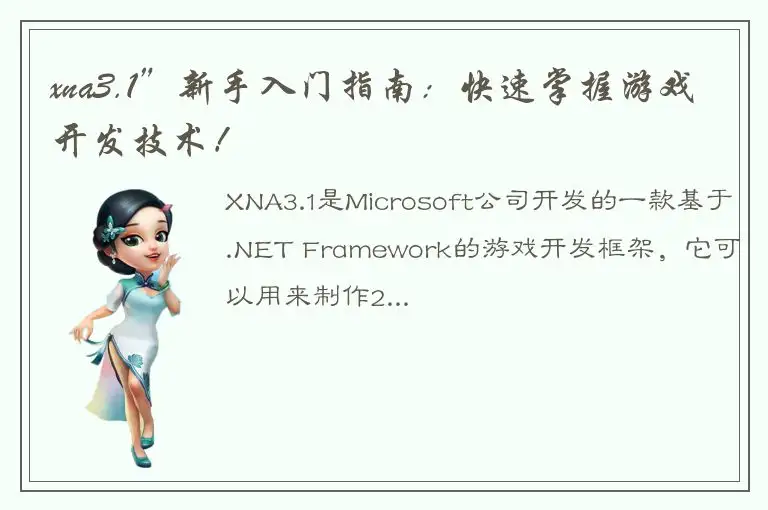XNA3.1是Microsoft公司开发的一款基于.NET Framework的游戏开发框架,它可以用来制作2D和3D的游戏。使用XNA3.1框架,你可以轻松地创建游戏所需的图形、声音和控件,同时还能利用现有的游戏开发工具和库。本文将为你介绍XNA3.1的基本概念和开发流程,帮助你快速上手,掌握游戏开发技术。
一、环境准备

首先,为了开始使用XNA3.1框架,你需要安装Visual Studio 2008或更高版本,以及XNA Game Studio 3.1。安装完成后,你可以在Visual Studio中创建一个XNA Game Studio项目。
二、创建游戏窗口
在创建游戏项目后,需要制作一个具有自定义背景颜色和实时更新的游戏窗口。可以在游戏窗口中添加游戏元素,如人物角色、道具和界面控件等。
public class Game1 : Microsoft.Xna.Framework.Game
{
private GraphicsDeviceManager graphics;
private SpriteBatch spriteBatch;
public Game1()
{
graphics = new GraphicsDeviceManager(this);
Content.RootDirectory = "Content"; //资源目录
}
protected override void Initialize()
{
// 初始化
base.Initialize();
}
protected override void LoadContent()
{
spriteBatch = new SpriteBatch(GraphicsDevice);
}
protected override void UnloadContent()
{
// 卸载资源
}
protected override void Update(GameTime gameTime)
{
// 游戏逻辑更新
base.Update(gameTime);
}
protected override void Draw(GameTime gameTime)
{
GraphicsDevice.Clear(Color.CornflowerBlue);
spriteBatch.Begin();
// 绘制游戏元素
spriteBatch.End();
base.Draw(gameTime);
}
}
三、添加游戏元素
在游戏窗口中添加游戏元素,需要先添加资源,如人物角色的贴图、音效等,可以通过Content.Load方法加载。然后在窗口中添加游戏元素对象,如Sprite、Texture、SoundEffect和Font等。
Texture2D player1Texture;
Texture2D player2Texture;
Texture2D backgroundTexture;
Vector2 player1Position;
Vector2 player2Position;
SoundEffect hitSound;
SpriteFont font;
protected override void LoadContent()
{
player1Texture = Content.Load
player2Texture = Content.Load
backgroundTexture = Content.Load
player1Position = new Vector2(100, 100);
player2Position = new Vector2(500, 100);
hitSound = Content.Load
font = Content.Load
}
四、添加交互操作
游戏操作与游戏元素的交互非常重要,可以通过键盘或鼠标事件实现。例如,移动人物角色、攻击敌人或播放音效等。
protected override void Update(GameTime gameTime)
{
KeyboardState keyboardState = Keyboard.GetState();
if (keyboardState.IsKeyDown(Keys.Left))
{
player1Position.X -= 5;
}
if (keyboardState.IsKeyDown(Keys.Right))
{
player1Position.X += 5;
}
base.Update(gameTime);
}
protected override void Draw(GameTime gameTime)
{
spriteBatch.Begin();
spriteBatch.Draw(player1Texture, player1Position, Color.White);
spriteBatch.Draw(player2Texture, player2Position, Color.White);
spriteBatch.Draw(backgroundTexture, Vector2.Zero, Color.White);
spriteBatch.DrawString(font, "Hello XNA!", new Vector2(100, 50), Color.Black);
spriteBatch.End();
base.Draw(gameTime);
}
五、调试与发布
在完成游戏开发后,可以进行调试和测试。可以通过添加调试信息、使用断点调试等方式进行调试。完成调试后,可以将游戏发布为可执行文件,以供玩家使用。
六、小结
本文介绍了使用XNA3.1框架创建游戏的基本流程。首先,需要准备开发环境,然后创建游戏窗口,添加游戏元素和交互操作,最后进行调试与发布。掌握这些基本技能后,就可以开发出自己的游戏作品了。




 QQ客服专员
QQ客服专员 电话客服专员
电话客服专员